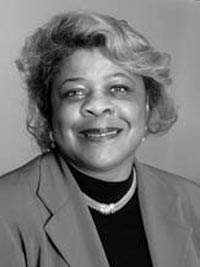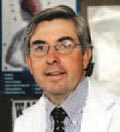
Stroke survivor Ruth Junious credits her quick recovery to a coworker who knew the warning signs.
Photo courtesy of NIH/NINDS
When I walked into the locker room at work, I realized something was wrong. I couldn't speak. I tried to pick up my lock, but my right hand couldn't grab it." For Ruth Junious, the sudden onset of a stroke was as bewildering as it was frightening.
"One of my co-workers noticed something was wrong and asked if I could write. With my left hand, I scribbled 911 on a piece of paper. Luckily, my friend knew the signs of stroke and got help. She called an ambulance, and I was rushed to the emergency room. The doctors ran some tests and put a drug into my IV. Within 10 minutes I could speak again." The fact that her coworker knew the signs of stroke and understood the importance of urgent medical attention, may have saved Junious's life. Today, she understands much more about this disorder that occurs to more than 700,000 Americans each year—and is more common among African-Americans than any other racial or ethnic group in the United States.
"I didn't know a thing about stroke before I had one," she says. "Now, I make sure that all my family knows the signs of stroke, so they can get help if they need it."
Stroke occurs when blood flow to your brain is stopped, either by blockage of a blood vessel supplying the brain or rupture of a blood vessel that causes bleeding into the brain. And once you have a stroke, your chances of having another stroke are
much greater. Many entertainers and other celebrities who have suffered a stroke go on to help warn others about the dangers, including such entertainers as Kirk Douglas (See page 8) and Della Reese, news broadcaster Mark McEwan, actress Julie Harris, and motivational speaker David Layton.
Preventing Stroke
"Until I had my stroke, I didn't do anything good for my health," says stroke survivor Ted Turner. "I had high blood pressure, I was overweight, and I smoked. When bad things happen to people, they tend to think 'why me?' But, when I think about my stroke, I think 'why not me?' I had all the risk factors and wasn't taking care of myself like I am now. I've learned a lot of important lessons from my stroke, which have caused me to change my eating habits, quit smoking, and really control my high blood pressure for the first time in my life. I hope people realize they can prevent stroke. It doesn't have to happen to them."
Like many stroke survivors, Turner knows the truth in the old saying that "an ounce of prevention is worth a pound of cure." That need to promote stroke prevention is one reason that the National Institute of Neurological Disorders and Stroke (NINDS) has developed a national "Know Stroke" educational campaign to help all Americans understand and respond to stroke. (See page 7 for more information.)
When Alma Shandling's husband Robert had a stroke, she knew just what to do.
"I could not speak," says Robert Shandling. "All I knew was that she was my wife, and I reached over and took her hand. I couldn't remember the names of my grandchildren or my daughters. I was a complete blank."
But Alma knew not only that it was a stroke, but that speed was of the essence. "I said to him, 'You're having a stroke. Stay here. I'm going to call an ambulance,'" Alma says. "He made it to the hospital in about 25 minutes, and six days later he walked out of the hospital. I think that is a miracle; I really do."

Walter Koroshetz, M.D., is Deputy Director of the National Institute of Neurological Disorders and Stroke (NINDS).
Photo courtesy of NIH/NINDS
"Somehow, we have to get the hopeful message out that there is something you can do. It's not hopeless; you can do something," says John Marler, M.D., NINDS Associate Director for Clinical Trials. "We've been able to develop a drug, t-PA, which you can inject in a vein, and it goes through the body, knows where the clot [causing the stroke] is, locks onto that clot, and dissolves it. And blood starts flowing again."
Since about 80 percent of strokes involve a blood clot, t-PA has been a major advance in the treatment of strokes.
In fact, the risk of stroke in any given year is actually decreasing, notes Walter J. Koroshetz, M.D., NINDS Deputy Director. "Stroke rates have been decreasing since the 1960s and '70s, and the annual risk of stroke death is still going down." Because stroke risk increases with age, as the population ages, total stroke incidence has not decreased. Progress in reducing risk is necessary just to keep up.
The challenge, Dr. Koroshetz adds, is to help people understand that some unhealthy lifestyle issues—high blood pressure, obesity, smoking—may prevent further declines in stroke rates. "Hypertension (high blood pressure) is the main risk factor for stroke," says Dr. Koroshetz. "And there is evidence that as you lower your cholesterol, stroke risk goes down. But the "epidemic" of obesity and sedentary lifestyle are acting against us. These are associated with high blood pressure and elevated cholesterol, atherosclerosis" (plaque buildup, causing narrowing in the arteries), and stroke risk.
